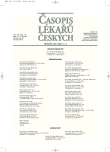Relationships Between the „Eating Inventory“ Factors, Socioeconomic Status, Anthropometric Body Adiposity Indexes and Health Risks in Czech Population
Vztahy mezi faktory „Dotazníku jídelních zvyklostí“, socioekonomickým stavem, antropometrickými ukazateli akumulace tuku a zdravotními riziky u české populace
Východisko.
Cílem práce bylo porovnat a zhodnotit psychologické charakteristiky jídelního chování hodnocené trojsložkovým dotazníkem jídelních zvyklostí Eating Inventory (EI) s antropometrickými, zdravotními a sociálními charakteristikami ve vzorku populace českých žen a mužů.
Metody a výsledky.
Vzorek zahrnoval 1624 žen a 1429 mužů, kteří byli jednotlivě dotazováni vyškolenými konzultanty. Vzorek populace byl kvótní s ohledem na pohlaví, věk, velikost místa bydliště, region, vzdělání a socioekonomický stav. Konzultanti získávali antropometrická data, socioekonomické informace a informace o životním stylu respondentů. Respondenti sami vyplnili dotazník EI. Zdravotní stav respondentů byl hodnocen podle údajů ošetřujících lékařů. Výsledky ukázaly, že ženy mají vyšší skóre restrikce, ale nižší skóre disinhibice a hladu než muži. Ve zpětné regresní krokové analýze se uplatnily v predikci body mass indexu (BMI) i obvodu pasu jak skóre dietní restrikce, tak skóre dietní disinhibice EI. BMI a obvod pasu negativně korelovaly s restrikcí a pozitivně s disinhibicí. Hlad a disinhibice prokazovaly vždy silnou vzájemnou provázanost. Restrikce byla u obou pohlaví v negativním vztahu s hladem, ale u mužů i s disinhibicí. U obou pohlaví stupeň vzdělání pozitivně koreloval s dietní restrikcí a negativně se skórem hladu. Významná negativní korelace mezi stupněm vzdělání a disinhibicí však byla prokázána pouze u mužů. Jedinci s vysokým skóre disinhibice (horní kvartil) vykazovali ve srovnání s jedinci s nízkým skóre disinhibice (dolní kvartil) vyšší výskyt hypertenze, kardiovaskulárních chorob a hyper/dyslipidémie, a to u obou pohlaví. Tyto rozdíly byly nejvíce vyjádřené u osob středního věku.
Závěry.
Psychologické charakteristiky jídelního chování hrají významnou úlohu při zmnožení tukové tkáně. Především disinhibice je významným způsobem spojena s výší BMI a obvodu pasu a s výskytem některých kardiometabolických onemocnění.
Klíčová slova:
Eating Inventory, restrikce, disinhibice, hlad, BMI, obvod pasu, komorbidity.
Authors:
M. Wagenknecht; V. Hainer; M. Kunešová; F. Bellisle 1; J. Pařízková; R. Braunerová; M. Hill; J. Lajka 2
Authors‘ workplace:
Endokrinologický ústav, Praha
; INRA Hotel Dieu, Paříž, Francie
1; Stem/Mark – Centrum sociologických a empirických studií, Praha
2
Published in:
Čas. Lék. čes. 2007; 146: 284-291
Category:
Original Article
Overview
Background.
The aim of the study was to compare and evaluate psychological traits of eating behaviour assessed using the Eating Inventory (EI) known also as the Three Factor Eating Questionnaire (TFEQ) and their relationship to body adiposity, health and social characteristic in a quota sample of Czech adults.
Methods and Results.
The sample included 1624 women and 1429 men who were interviewed individually by instructed investigators. The sample was quota representative – for gender, age, size of residential location, region and socioeconomic status in Czech adults. Anthropometric data were obtained together with socioeconomic and lifestyle information. Subjects filled out the EI. Health status was evaluated according to the data reported by GPs. Our results show, that women had higher restraint but lower disinhibition and hunger scores than men. Hunger and disinhibition were always strongly associated, whereas restraint was negatively related to the other two factors in men, and to hunger in women. In both men and women an educational level positively correlated with dietary restraint and negatively with hunger. However, significant negative relationship between educational level and disinhibition was revealed only in men. In backward stepwise regression analysis both dietary restraint and disinhibition predicted BMI and waist circumference. BMI and waist circumference were negatively related to restraint, but positively to disinhibition. Restraint and disinhibition were associated with prevalence of comorbidities in men, while disinhibition and hunger were in women. Individuals with high scoring in disinhibition score (upper quartile) exhibited significantly higher prevalence of hypertension, cardiovascular diseases and hyperlipidaemia than those who scored low (lower quartile). These relationships were most marked in middle-aged subjects.
Conclusions.
Psychological traits of eating behaviour seem to have an important role in the development and clinical expression of body adiposity. Especially disinhibition is significantly associated with BMI and waist circumference and prevalence of several pathologies.
Key words:
Eating Inventory, dietary restraint, disinhibition, body mass index, waist circumference, comorbidities.
Labels
Addictology Allergology and clinical immunology Angiology Audiology Clinical biochemistry Dermatology & STDs Paediatric gastroenterology Paediatric surgery Paediatric cardiology Paediatric neurology Paediatric ENT Paediatric psychiatry Paediatric rheumatology Diabetology Pharmacy Vascular surgery Pain management Dental HygienistArticle was published in
Journal of Czech Physicians

- Metamizole vs. Tramadol in Postoperative Analgesia
- Metamizole at a Glance and in Practice – Effective Non-Opioid Analgesic for All Ages
- Advances in the Treatment of Myasthenia Gravis on the Horizon
- What Effect Can Be Expected from Limosilactobacillus reuteri in Mucositis and Peri-Implantitis?
- The Importance of Hydration in Wound Healing
Most read in this issue
- Neurosteroids and Their Function
- Relationships Between the „Eating Inventory“ Factors, Socioeconomic Status, Anthropometric Body Adiposity Indexes and Health Risks in Czech Population
- Obesity Based on Mutation of Genes Involved in Energy Balance
- Growth Hormone Treatment in the Institute of Endocrinology
